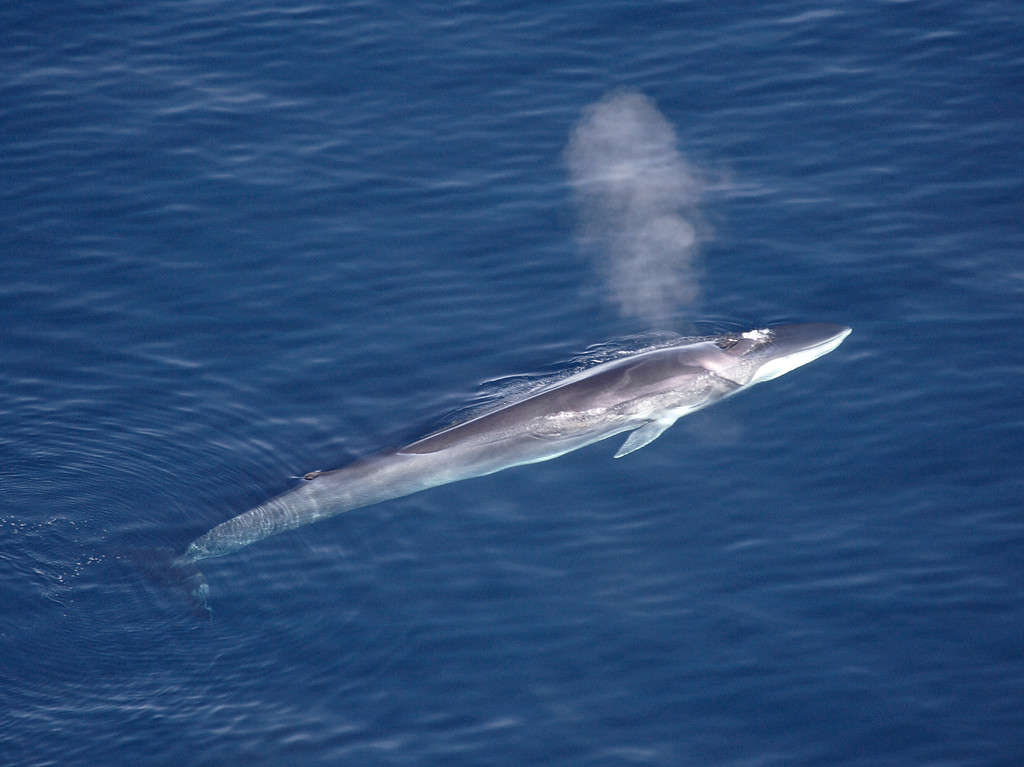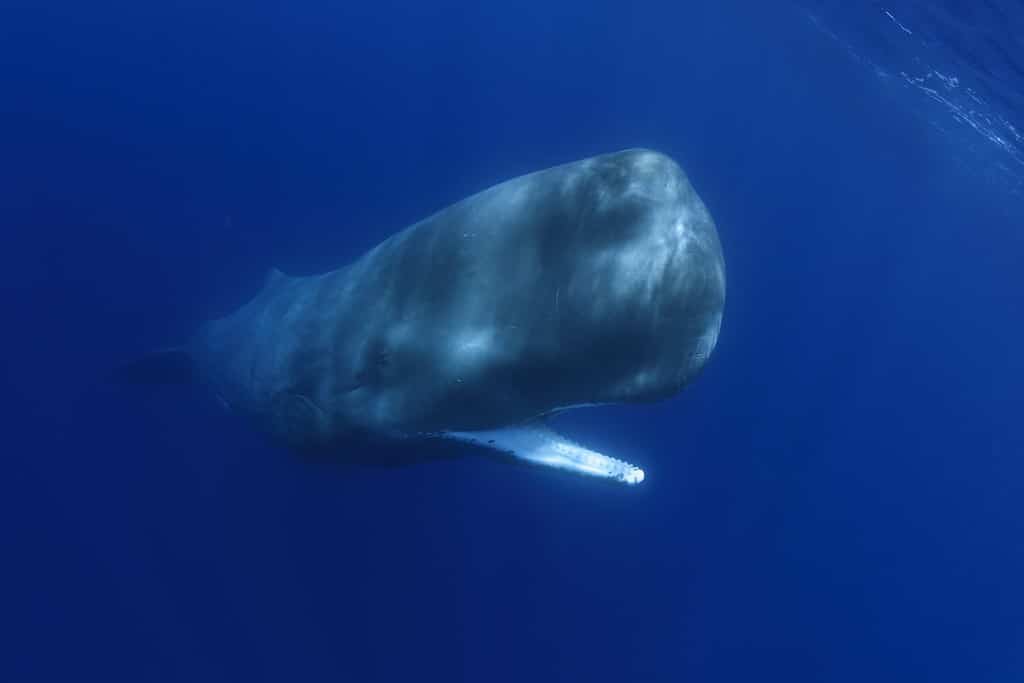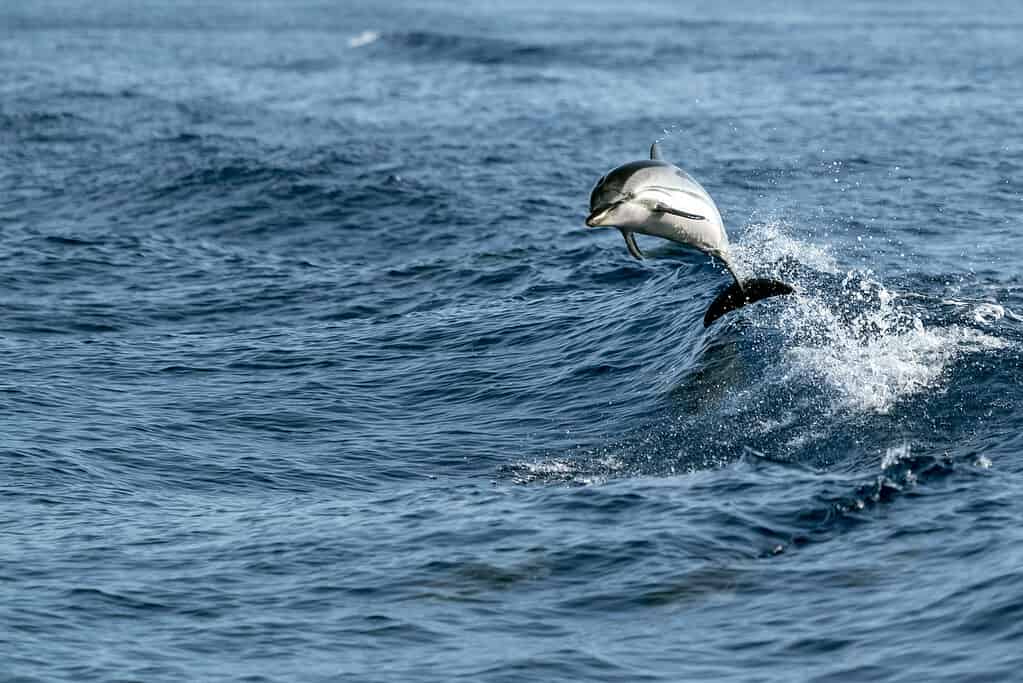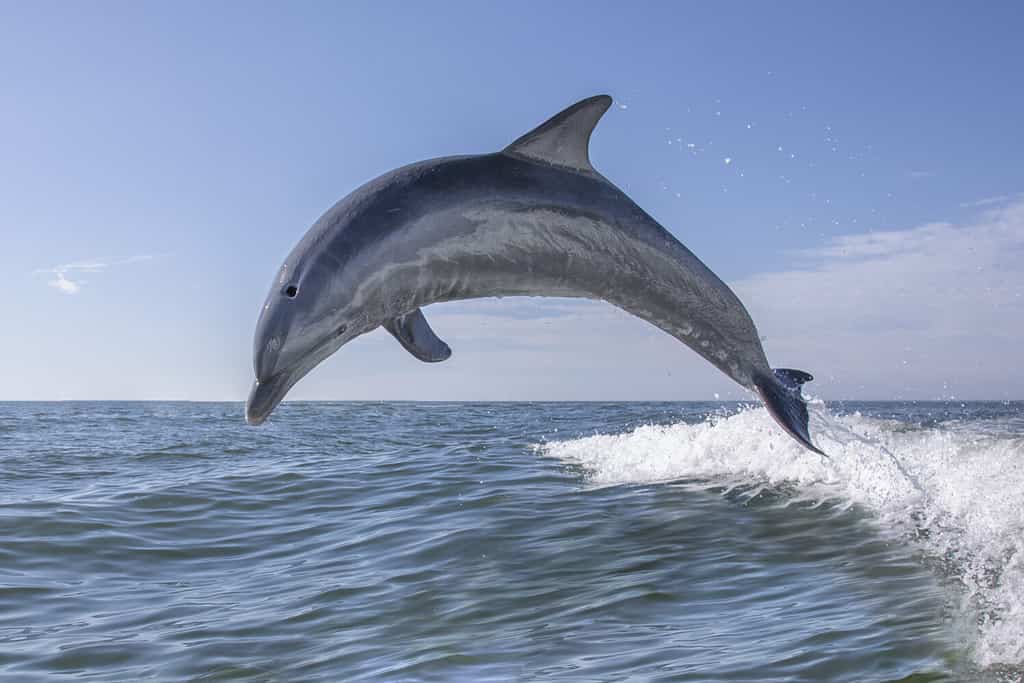Whales are some of the most beautiful and intelligent creatures to ever live. They are gentle in many ways yet ferocious and quick in others. Looking into a whale’s eyes, you can see a conscious being looking back at you. Most of the world’s major oceans and seas have some presence of whales. Today, we are going to take a look at one of the most important regions of the world, the Mediterranean Sea, and learn what types of whales live in its waters. Let’s get started.
The 8 Types of Whales in the Mediterranean Sea
Fin Whale

Fin whales are the second largest animals in the world, behind
blue whales
.
©Aqqa Rosing-Asvid – Visit Greenland, CC BY 2.0 – License
The fin whale (Balaenoptera physalus) is the only baleen whale that lives in the Mediterranean Sea and the second largest whale species in the world, after the blue whale. They are impressively, incredibly huge. It has a sleek, streamlined body with a V-shaped head and a tall fin on its back ( hence the name). It is brownish-gray on the upper side, whereas a blue whale is, well, blue. Fin whales can grow up to 24 meters (79 feet) long and weigh up to 70 tons.
Fin whales are found in all the major oceans, from polar to tropical waters. However, they prefer temperate and cool regions. They are almost exclusively migratory and travel between feeding and breeding grounds. In the Mediterranean Sea, they are primarily concentrated in the Ligurian Sea, the Corsican Sea, and the Tyrrhenian Sea.
Commercial whaling has a significant impact on fin whales. The industry killed nearly 750,000 animals in the Southern Hemisphere alone between 1904 and 1979. They currently have an endangered status by the International Union for Conservation of Nature (IUCN) and are protected by the International Whaling Commission (IWC). The global population of fin whales is estimated to range from 50,000 to 119,000 individuals, with about 3,500 to 4,000 in the Mediterranean Sea.
Sperm Whale

Sperm whales are often viewed as the largest predators on the planet.
©Thierry Eidenweil/Shutterstock.com
The sperm whale (Physeter macrocephalus) is the world’s largest species of toothed whale. Also, it’s the largest toothed predator in the world (sorry, tigers). It features a pretty distinctive shape with a huge square head. The head makes up about one-third of its body length to make room for all its teeth. They can grow up to 24 meters (79 feet) long and weigh up to 63 tons.
Sperm whales are widely distributed, although they stick to deeper ocean regions for their prey. Bulls (males) tend to live alone or in loose groups with other single males. They feed mainly on squid, most famously giant squid. They can dive deeper than any other whale, sometimes hitting 7,382 feet down and holding their breath for more than an hour.
Sperm whales have been hunted by humans for centuries, mainly for their spermaceti (where they get their name), a waxy substance in their head that was used for oil lamps and lubricants. They also produce ambergris, a waxy substance used in perfumes. The global population of sperm whales is estimated to range from 300,000 to 450,000 individuals, with about 2,000 in the Mediterranean Sea.
Striped Dolphin

Striped dolphins get their name from their striped sides.
©izanbar/iStock via Getty Images
The striped dolphin (Stenella coeruleoalba) is a small dolphin that lives in warm and tropical waters. It is the Mediterranean’s most common dolphin species, with an estimated population of about 150,000 across the entirety of the sea.
The striped dolphin has a famous pattern (hence the name) that helps watchers recognize them. The striped dolphin can grow up to 2.6 meters (8.5 feet) long and weigh up to 160 kilograms (352 pounds).
This dolphin is highly social and can live in groups of up to 100 members.
Bottlenose Dolphin

Bottlenose dolphins are basically the “iconic” image people think of when they think of dolphins.
©Tory Kallman/Shutterstock.com
The bottlenose dolphin (Tursiops truncates) may just be everyone’s favorite dolphin, and they are one of the most iconic and well-known dolphin species in the world. They live throughout warm and temperate oceans. The bottlenose dolphin may appear in the Atlantic, Pacific, and Indian Oceans, as well as the Mediterranean and Black Seas. They can grow up to 4 meters (13 feet) long and weigh up to 650 kilograms (1,430 pounds).
Bottlenose dolphins are highly intelligent and live in groups of 2 to 30, known as pods. They feed mainly on fish, squid, and crustaceans, sometimes using group hunting techniques to catch schools of fish together.
Bottlenose dolphins have a long history with humans. During the Vietnam War, the United States Navy trained bottlenose dolphins, along with other sea animals, to deliver equipment to undersea divers and fetch objects, among other tasks. Bottlenose dolphins appear in the world’s aquariums, sometimes as a rescue. Currently, they are marked least concern by the IUCN.
Risso’s Dolphin

Risso’s dolphins have rounded heads and no snouts. They get whiter the older they get.
©iStock.com/PeakMystique
The Risso’s dolphin (Grampus griseus) is a very rare dolphin that inhabits temperate and tropical waters around the world. Sightings are rare because they mostly reside in deep waters where they wait for prey.
The Risso’s dolphin is also quite strange looking. It has a stout little body, a large bulb-like head, and no real snout. The older the dolphin, the whiter its body becomes. The Risso’s dolphin can grow up to 4 meters (13 feet) long and weigh up to 500 kilograms (1,100 pounds).
Risso’s dolphins currently rank as Least Concern by the IUCN, although the group lacks a global population estimate.
Long-Finned Pilot Whale

There are two ecotypes of pilot whales, long and short-finned.
©Andrew Sutton/Shutterstock.com
The long-finned pilot whale (Globicephala melas) is a large deep-diving dolphin (despite its name) that inhabits cold and temperate waters. It is one of the most common cetaceans in the Mediterranean Sea, with an estimated population of about 30,000.
The long-finned pilot whale has a bulbous forehead (although not as bulbous as Risso’s), a short and curved dorsal fin, and long and pectoral fins, which contribute to their name. It can grow up to 6.5 meters (21 feet) long and weigh up to 2.3 metric tons (2.5 tons).
Short-Beaked Common Dolphin

Common dolphins live in most oceans and seas around the world.
©iStock.com/Redders48
The short-beaked common dolphin (Delphinus delphis) is a small and “common” dolphin that inhabits most warm waters around the world. It has some of the highest population numbers of any dolphin species in the world, with an estimated population of about 6 million.
The bottlenose dolphin is usually seen as the visual “standard” for dolphins, but the common dolphin is technically the original version depicted in art. It has a gray upper body with yellowish hourglass patterns down its sides. The short-beaked common dolphin can grow up to 2.7 meters (8.9 feet) long and weigh up to 110 kilograms (240 pounds).
There is some debate as to the classification of the common dolphin. The short-beaked common dolphin is currently listed as one of two members of the species, although they aren’t considered separate anymore.
Cuvier’s Beaked Whale

Recognized for its unique bear, the Cuvier’s beaked whale is the deepest-diving and longest-breath-holding winner of all mammals.
©iStock.com/HeitiPaves
The Cuvier’s beaked whale (Ziphius cavirostris) is a somewhat elusive whale that lives in most oceans except the polar regions, but when it is seen, its notable beak helps to identify it.
The Cuvier’s beaked whale has a pair of teeth at the tip of its lower jaw that are only visible in males. It can grow up to 7 meters (23 feet) long and weigh up to 3 metric tons (3.3 tons).
Besides having a beak, it has a little claim to fame as the longest and deepest diving mammal in the world. Currently, its record is 137 minutes and 2,992 meters (9,816 feet).
Honorable Mentions (Whales That Occasionally Venture Near the Mediterranean)
These are non-native whales that sometimes appear in the Mediterranean but don’t usually live there.
- Minke whale
- Humpback whale
- Right whale
- Gray whale
- Killer whale
- False killer whale
The photo featured at the top of this post is © Cephas, CC BY-SA 3.0 – License / Original
Thank you for reading! Have some feedback for us? Contact the AZ Animals editorial team.






